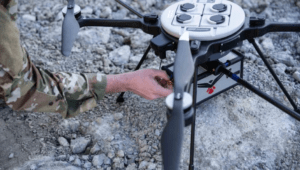
“RedTail LiDAR Systems, a leader in microelectromechanical systems (MEMS) mirror-based light detection and ranging (LiDAR) technology, has delivered six LiDAR systems to the 707th Ordnance Company stationed at Joint Base Lewis-McChord,” says a press release. The deployment will allow the EOD techs to explore how drone-based LiDAR systems can be used to meet their goals.
The testing is focused on using LiDAR to map terrain. LiDAR produces 3D maps, referred to as point clouds, that allow users to view mapped areas from any perspective, traveling around the models in 3D space using rotation and zoom capabilities in the viewer software. This functionality will enable the EOD technicians to use the RedTail LiDAR Systems RTL-450, integrated onto the Teledyne FLIR SkyRaider Unmanned Aerial System (UAS), to perform a broad range of functions: calculating crater volumes from improvised explosive device (IED) blasts, planning routes for unmanned ground vehicles, mission planning, and surveillance.
MEMS Drone-Based LiDAR for Denser Point Clouds
The system can operate in either a raster scan mode for surveillance missions or a side-to-side line scan mode for area mapping while the UAS is flying. The intuitive command and control, high-brightness display integrated into the ground control station (GCS), and real time 3D map generation allows operators to begin mission planning and analysis even before the mapping or surveillance missions are completed.
“Delivering these six LiDAR systems to EOD technicians for test and evaluation is a significant step forward in using MEMS mirror-based LiDAR technology to address a broad range of Department of Defense 3D mapping needs. In addition, this delivery represents a true success story in transitioning a technology out of a Department of Defense laboratory and back into the hands of military operators,” said Brad DeRoos, President and CEO of RedTail LiDAR Systems.
To read more about drone-based LiDAR technology, read these previous articles on coaxial drones equipped with LiDAR, micro LiDAR sensors, the differences between LiDAR and photogrammetry, and how LiDAR is used in commercial drone applications.
Miriam McNabb is the Editor-in-Chief of DRONELIFE and CEO of JobForDrones, a professional drone services marketplace, and a fascinated observer of the emerging drone industry and the regulatory environment for drones. Miriam has penned over 3,000 articles focused on the commercial drone space and is an international speaker and recognized figure in the industry. Miriam has a degree from the University of Chicago and over 20 years of experience in high tech sales and marketing for new technologies.
For drone industry consulting or writing, Email Miriam.
TWITTER:@spaldingbarker
Subscribe to DroneLife here.